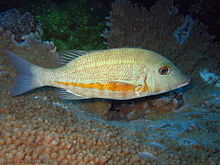Lethrinus obsoletus
| Lethrinus obsoletus | |
|---|---|

| |
| Scientific classification | |
| Domain: | Eukaryota |
| Kingdom: | Animalia |
| Phylum: | Chordata |
| Class: | Actinopterygii |
| Order: | Acanthuriformes |
| Family: | Lethrinidae |
| Genus: | Lethrinus |
| Species: | L. obsoletus
|
| Binomial name | |
| Lethrinus obsoletus | |
| Synonyms[3] | |
| |
Lethrinus obsoletus, the orange-striped emperor, yellow-banded emperor or yellowstripe emperor, is a species of marine ray-finned fish belonging to the family Lethrinidae, the emperors or emperor breams. This species has a wide Indo-Pacific distribution.
Taxonomy
[edit]Lethrinus obsoletus was first formally described as Sciaena obsoleta by the Swedish-speaking Finnish explorer, orientalist, naturalist Peter Forsskål and published in 1775 in Descriptiones animalium edited by Carsten Niebuhr with no Type locality being given but it is assumed to be the Red Sea.[4] Some authors place the genus Lethrinus in the monotypic subfamily Lethrininae, with all the other genera of Lethrinidae placed in the Monotaxinae, however, the 5th edition of Fishes of the World does not recognise the subfamilies traditionally accepted within the family Lethrinidae as valid. The family Lethrinidae is classified by the 5th edition of Fishes of the World as belonging to the order Spariformes.[5]
Etymology
[edit]Lethrinus obsoletus has the specific name obsoletus which means "worn out" or “decayed”, this appears to be an allusion to the faint yellow-purple stripe, which was described as “orange-yellow” in contemporaneous accounts.[6]
Description
[edit]Lethrinus obsoletus has its dorsal fin supported by 10 spines and 9 soft rays while there are 2 spines ands 8 soft ratys supporting its anal fin.[3] The body is moderately deep, the depth fitting into its standard length 2.4 to 2.8 times. The dorsal profile of the head around the eye is straight or a little convex and on the snout it is also slightly convex.[7] The teeth in the jaws at the sides of the mouth are rounded or conical. The axilla of the pectoral fin is densely scaled.[8] The overall colour is light tan to olive-brown with a horizontal yellow-orange stripe along the lower flank between the base of the pectoral fin to the caudal peduncle. There are two indistinct yellowish orange stripes above the main stripe and there are a number of wide, faint, vertical and oblique dark and light coloured bands on the head, with white spots sometinmes shoeing under the eyes. The fins are whitish or yellowish brown and are sometimes blotched.[9] This species has a maximum published total length of 60 cm (24 in), although 30 cm (12 in) is more typical.[3]
Distribution and habitat
[edit]Lethrinus obsoletus has a wide distribution in the Indian and Western Pacific Oceans. It is found along the coast of eastern Africa from the Red Sea south to Sodwana Bay in South Africa.[8] It is found acroos the Indian Ocean into the Pacific as far as the Ryukyu Islands, Tonga and Samoa.[1] In Australian waters it is found at Rowley Shoals, Scott Reef and Hibernia Reef off Western Australia, the Cocos (Keeling) Islands, Ashmore Reef in the Timor Sea and along the northern Great Barrier Reef off Queensland,[9] The orange-striped emperors is typically found in seagrass beds, as well as over sand and rubble areas in lagoons and in reefs. The juveniles prefer seagrass beds and then as they grow they begin to live in reefs. They are found as deep as 30 m (98 ft).[9]
Biology
[edit]Lethrinus obsoletus preys mainly on crustaceans, molluscs and echinoderms.[3] It is a protogynous hermaphrodite,[9] and in Palau spawning takes place between November and April with spawning happening monthly, on the last 5 days of the lunar month.[7]
References
[edit]- ^ a b Carpenter, K.E.; Lawrence, A.; Myers, R. (2016). "Lethrinus obsoletus". IUCN Red List of Threatened Species. 2016: e.T16720267A16722420. doi:10.2305/IUCN.UK.2016-3.RLTS.T16720267A16722420.en. Retrieved 15 December 2023.
- ^ Nicolas Bailly (2008). "Lethrinus obsoletus (Forsskål, 1775)". WoRMS. World Register of Marine Species. Retrieved 15 December 2023.
- ^ a b c d Froese, Rainer; Pauly, Daniel (eds.). "Lethrinus obsoletus". FishBase. October 2023 version.
- ^ Eschmeyer, William N.; Fricke, Ron & van der Laan, Richard (eds.). "Species in the genus Lethrinus". Catalog of Fishes. California Academy of Sciences. Retrieved 16 December 2023.
- ^ Nelson, J.S.; Grande, T.C.; Wilson, M.V.H. (2016). Fishes of the World (5th ed.). Hoboken, NJ: John Wiley & Sons. pp. 502–506. doi:10.1002/9781119174844. ISBN 978-1-118-34233-6. LCCN 2015037522. OCLC 951899884. OL 25909650M.
- ^ "Order SPARIFORMES: Families LETHRINIDAE, NEMIPTERIDAE and SPARIDAE". The ETYFish Project Fish Name Etymology Database. Christopher Scharpf. 17 October 2022. Retrieved 14 December 2023.
- ^ a b Kent E. Carpenter; Gerald R. Allen (1989). Emperor fishes and large-eye breams of the world (Family Lethrinidae). An annotated and illustrated catalogue of lethrinid species known to date (PDF). FAO Species Catalogue. Vol. 9. FAO, Rome. pp. 77–78.
- ^ a b Kent E. Carpenter (2022). "Family Lethrinidae". In Phillip C Heemstra; Elaine Heemstra; David A Ebert; Wouter Holleman; John E Randall (eds.). Coastal Fishes of the Western Indian Ocean (PDF). Vol. 3. South African Institute for Aquatic Biodiversity. pp. 316–327. ISBN 978-1-990951-32-9.
- ^ a b c d "Lethrinus obsoletus". Fishes of Australia. Museums Victoria. Retrieved 16 December 2023.
External links
[edit] Media related to Lethrinus obsoletus at Wikimedia Commons
Media related to Lethrinus obsoletus at Wikimedia Commons- Photos of Lethrinus obsoletus on Sealife Collection

